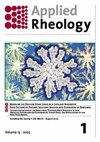利用洛伦兹力计算分析经过旋转球体的纳米粒子和废物排放浓度
IF 1.8
4区 工程技术
Q1 MECHANICS
引用次数: 0
摘要
随着各行各业越来越依赖磁流体动力(MHD)系统在动力、生产和环境管理方面的不同用途,优化这些操作变得至关重要。这项研究旨在通过研究这些错综复杂的相互联系,提高冷却结构、化学反应反应堆和污染物控制方法的效率和生产力。因此,本研究仔细研究了内热/外热(EN/EX)化学过程、对流边界条件以及污染物浓度对围绕旋转球体的 MHD 纳米流体循环的影响。基于上述假设的控制方程被简化为常微分方程系统,并采用 Runge-Kutta Fehlberg 四阶和五阶方案进行数值求解。结果表明,随着外部污染物本地源和固体体积百分比的增加,传质速率降低。随着活化能参数值和固体分数的变化,EN 情况下的热扩散率下降,EX 情况下的热扩散率上升。随着外部污染源变化参数和本地污染源参数的增加,浓度曲线也随之增加。本研究成果可用于冷却设备、开发先进的污染控制方法、环境管理、MHD 发电机和各种工业环境。本文章由计算机程序翻译,如有差异,请以英文原文为准。
Computational analysis of nanoparticles and waste discharge concentration past a rotating sphere with Lorentz forces
As industries rely more and more on magnetohydrodynamic (MHD) systems for different uses in power, production, and management of the environment, it becomes essential to optimize these operations. The study seeks to improve the effectiveness and productivity of cooling structures, chemical reaction reactors, and contaminant control methods by investigating these intricate interconnections. Because of this, the work scrutinizes the endothermic/exothermic (EN/EX) chemical processes, convective boundary conditions, and pollutant concentration impacts on MHD nanofluid circulation around a rotating sphere. The governing equations based on the above assumptions are reduced into a system of ordinary differential equations and solved numerically with Runge–Kutta Fehlberg’s fourth- and fifth- order schemes. The obtained numerical outcomes from the numerical scheme are presented with the aid of graphs, and the results show that the rate of mass transfer decreases with an increase in the external pollutant local source and solid volume percentage. For changes in the values of the activation energy parameter and solid fraction, the rate of thermal dispersion drops for the EN case and upsurges for the EX case. The concentration profile shows increment with the addition of the external pollutant source variation parameter and local pollutant external source parameter. The outcomes of the present work can be helpful in cooling equipment, developing advanced methods for controlling pollution, environmental management, MHD generators, and various industrial contexts.
求助全文
通过发布文献求助,成功后即可免费获取论文全文。
去求助
来源期刊

Applied Rheology
物理-力学
CiteScore
3.00
自引率
5.60%
发文量
7
审稿时长
>12 weeks
期刊介绍:
Applied Rheology is a peer-reviewed, open access, electronic journal devoted to the publication in the field of applied rheology. The journal provides the readers with free, instant, and permanent access to all content worldwide; and the authors with extensive promotion of published articles, long-time preservation, language-correction services, no space constraints and immediate publication.
 求助内容:
求助内容: 应助结果提醒方式:
应助结果提醒方式:


